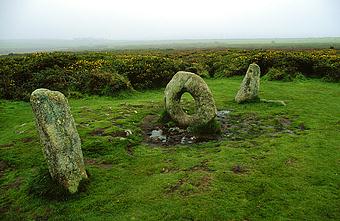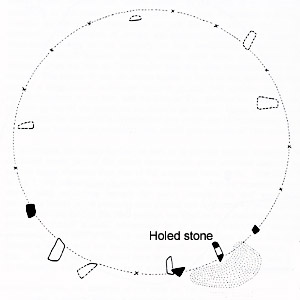|
Location:
Cornwall, Nr Madron. (O/S
- SW 4265 3494). |
Grid Reference:
50� 9' 30" N, 5� 36' 16" W. |

 Men an Tol:
(Stone Circle, Holed Stone).
Men an Tol:
(Stone Circle, Holed Stone).
The original design
of these megalithic remains have evoked much debate in the past,
however, following the recent discovery of several recumbent stones
lying beneath the turf, it is now realised that these three granite
stones were once part of a stone-circle.
(2)
Unfortunately this popularity is not without its downside,
recently someone tried to destroy the Men-an-Tol by covering it with a homemade
napalm mixture and setting it on fire. Fortunately the stones survived the
ordeal, but the residue from the attack still thickly coats some parts of the
stones
|
Men an Tol: ('The
Crick Stone', 'The Devil's Eye') |
The
M�n-an-Tol monument consists of four stones: one fallen, two uprights, and
between these a circular one, 1.3m (4ft 6in) in diameter, pierced by a hole
about half its size in diameter. An old plan of M�n-an-Tol (the name means
'stone with a hole' in Cornish) shows that originally the three main
stones stood in a triangle, which makes archaeo-astronomical claims
for it difficult to support. They could be the remains of a Neolithic 'tomb',
because holed stones are known to have have served as entrances to chambers. Its age in
uncertain but it is usually assigned to the Bronze Age, between 3000-4000
years ago.
Antiquarian representations of the site differ in significant details
and it is possible that the elements of the site have been rearranged on
several occasions. William Borlase described the monument in the 18th
Century as having a triangular layout, and it has been suggested that
the holed stone was moved from its earlier position to stand in a direct
alignment between the two standing stones. In the mid 19th Century, a
local antiquarian JT Blight proposed that the site was in fact the
remains of a stone circle. This idea was given additional support when a
recent site survey identified a number of recumbent stones lying just
beneath the modern turf which were arranged along the circumference of a
circle 18 metres in diameter. The recumbent stones are somewhat
irregularly spaced but the three extant upright stones have smooth
inward facing surfaces and are of a similar height to other stone
circles in Penwith.
If this is indeed the origin of the site, the holed stone would probably
have been aligned along the circumference of the circle and would have
had a special ritual significance possibly by providing a lens through
which to view other sites or features in the landscape, or as a window
onto other worlds. There have also been suggestions that it may have
been a component of a burial chamber or cist. There are instances of
burial chambers close to stone circles, as at nearby Boskednan, and a
barrow mound with stone cist has been identified to the north-east of
the Men-an-Tol, so it seems likely that the site was part of a more
extensive ritual or ceremonial complex.
Although the Men-an-Tol is considered to be Bronze Age in date no
extensive excavations have taken place. The discovery of a single flaked
flint by WC Borlase in 1885 is hardly compelling evidence for an early
date whilst the recent works to reset the holed stone revealed only
evidence for modern activity.
|
Holed Stones.
Holed stones are found in many parts of British Isles as well as in other
countries of the world; together with holy wells they have retained the
ideas and customs associated with them more tenaciously than any other
type of ancient sites. Beliefs connected with them are remarkably similar
from the Orkneys to the far west of Cornwall.
Holed stones are very rare in prehistoric Cornwall; there is only one
other comparable site, the Tolvan Stone near Gweek. All other �holed
stones� are much smaller with holes less than 15 cm in diameter; certainly
too small to pass an infant through. These stones may have originated as
horizontally bedded stones on granite tors, the hole produced by natural
weathering processes. They may have been brought to the site to fulfil a
specific ritual purpose and perhaps to provide a physical link with the
sacred hill.
(1)
There are a number of Holed stones in the Maltese temples such as
Hagar Qim and
Mnajdra. The
Great
Pyramid in
Egypt incorporates both Holed
Stones and a well into its structure.
(More about
Holed Stone)
|
Legend and Tradition:
Traditional rituals at M�n-an-Tol (centuries ago known also as
Devil's Eye) involved passing naked children three times through the
holed stone and then drawing them along the grass three times in an
easterly direction. This was thought to cure scrofula (a form of
tuberculosis) and rickets. Adults seeking relief from rheumatism, spine
troubles or ague were advised to crawl through the hole nine times against
the sun. The holed stone also had prophetic qualities and, according to
nineteenth-century folklorist Robert Hunt: If two brass pins are
carefully laid across each other on the top edge of the stone, any
question put to the rock will be answered by the pins acquiring, through
some unknown agency, a peculiar motion.
The Men-an-Tol has generated a wealth of folklore and tradition. It is
renowned for curing many ailments, particularly rickets in children, by
passing the sufferer through the hole. It was also said to provide an
alternative cure �scrofulous taint�, also known as the �Kings Evil�
which was otherwise only curable by the touch of the reigning monarch.
The site�s reputation for curing back problems earned it the name of
�Crick Stone�. The stones were also seen as a charm against witchcraft
or ill-wishing, and could also be used as a tool for augury or telling
the future; two brass pins laid crosswise on top of each other on the
top of the stone would move independently of external intervention in
accordance with the question asked. Age old myths of spirits associated
with sacred places are echoes from prehistory.
(1)
News and
Recent Events at Men an Tol.
Article:
'Ancient Monument Damaged By
Cattle': (2013)
'One of the West country's most famous archaeological
landmarks is being threatened by grazing cattle
permitted by the Government's environment watchdog,
campaigners have warned... It is obvious that the
cattle had been using the stones as convenient 'rubbing
posts", said Mr Cooke from the Penwith action group. A
spokesman for English Heritage said the stones were set
in concrete in the 1940's and reset in 1993 in response
to concerns about soil erosion around the stones caused
by visitor pressure. He added: "We do not, however,
expect cattle activity to cause damage to the stones or
its setting..."
(Link
to Full Article)
Article:
'Cornish Megaliths
Vandalized': (1999)
'Napalm was
poured over two of Cornish (England) most ancient monuments
and then set ablaze. In an anonymous letter sent to The
Cornishman - the local newspaper - a group calling themselves
Friends of the Stone said they had ceremoniously burnt the
famous Men-an-Tol holed
stone and the nearby Lanyon
Quoit. The writer of the anonymous letter to The
Cornishman included three photographs of the two ancient
monuments covered in burning oil and ablaze with flames.
The police at Penzance are taking the matter seriously.
"We have to assume it is napalm, so I will be talking to the
council about getting the sites cordoned off for public safety
reasons until the monuments can be cleaned," one of the police
officers said. "Until we know exactly what the substance is
that was used to burn the stones, no one should touch it, or
go near the monuments."
Cheryl Straffon, a member of Penwith Council's Sacred
Sites Committee, confirmed that the stones were indeed badly
damaged on November 5 and that the incident had been reported
to the Cornwall Archeological Unit, English Heritage and the
National Trust. She said that "Something did occur on November
5 at the Men-an-Tol and discovered the next day. It looks as
if resin of some sort has been poured over the holed stone and
an attempt made to set it alight."
When a Cornishman reporter visited the Lanyon Quoit he
found three of the upright supports badly burnt by a blackened
substance and the huge roof stone also blacked and covered in
a sticky mess of black and white gunge.
The writer of the anonymous letter stated: "You do not
deserve the heritage these monuments hold and therefore we
intend to act further. By this time next week, Men-an-Tol will
be gone. It shall be set up again, correctly aligned with
pertinent sacred stones, in my back garden."
Anne Preston-Jones of English Heritage said that she would be
inspecting the monuments. "I will be compiling a damage
report," she said. "We can't even remove the substance until
permission is given as these are ancient monuments."
(Other Desecrated Megaliths)
(Source: The Cornishman.
November 1999) |
Alignments - The circular stone aligns exactly with
the centre stone at
Boscawen-Un and the church at nearby St Buryan. While this may
conceivably be coincidental, the precision of the alignment suggests an
intentional positioning of the structures in relation to each other.
(Other
Examples of Holed Stones)
(Other Stone
Circles)
(Other Prehistoric English sites)
|

